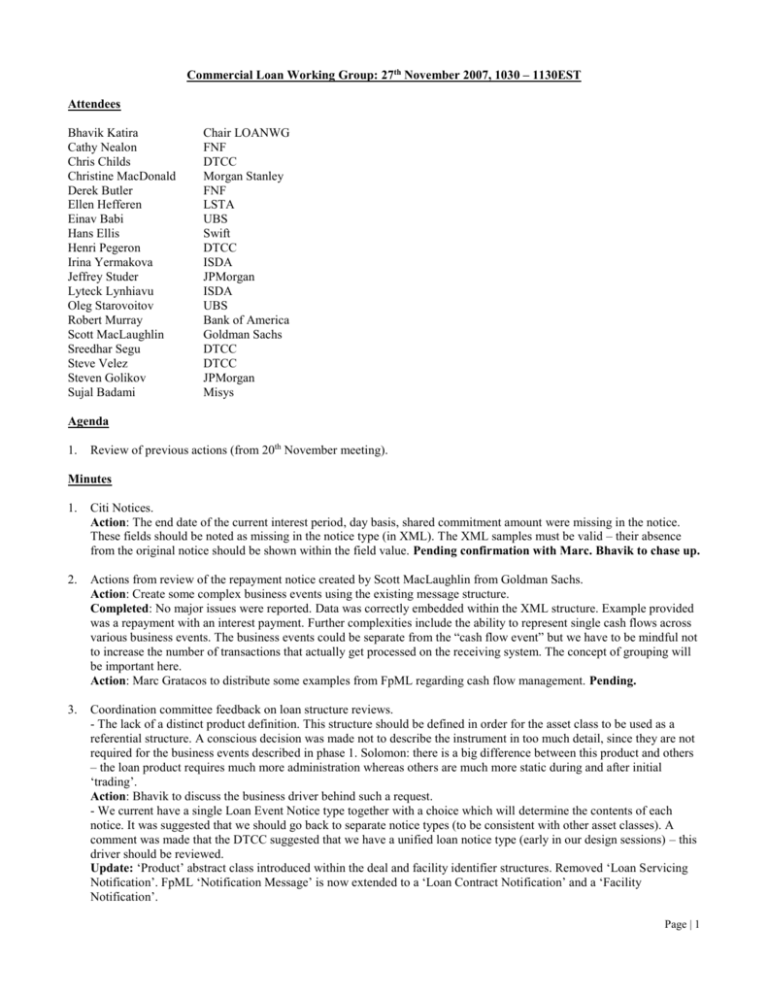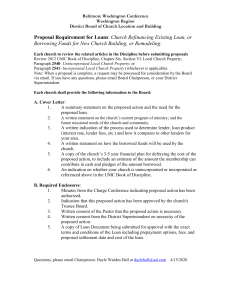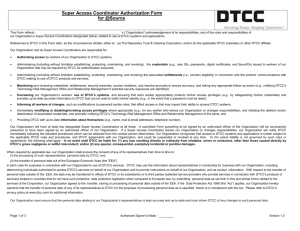Commercial Loan Working Group: 27th November 2007, 1030 – 11
advertisement

Commercial Loan Working Group: 27th November 2007, 1030 – 1130EST Attendees Bhavik Katira Cathy Nealon Chris Childs Christine MacDonald Derek Butler Ellen Hefferen Einav Babi Hans Ellis Henri Pegeron Irina Yermakova Jeffrey Studer Lyteck Lynhiavu Oleg Starovoitov Robert Murray Scott MacLaughlin Sreedhar Segu Steve Velez Steven Golikov Sujal Badami Chair LOANWG FNF DTCC Morgan Stanley FNF LSTA UBS Swift DTCC ISDA JPMorgan ISDA UBS Bank of America Goldman Sachs DTCC DTCC JPMorgan Misys Agenda 1. Review of previous actions (from 20th November meeting). Minutes 1. Citi Notices. Action: The end date of the current interest period, day basis, shared commitment amount were missing in the notice. These fields should be noted as missing in the notice type (in XML). The XML samples must be valid – their absence from the original notice should be shown within the field value. Pending confirmation with Marc. Bhavik to chase up. 2. Actions from review of the repayment notice created by Scott MacLaughlin from Goldman Sachs. Action: Create some complex business events using the existing message structure. Completed: No major issues were reported. Data was correctly embedded within the XML structure. Example provided was a repayment with an interest payment. Further complexities include the ability to represent single cash flows across various business events. The business events could be separate from the “cash flow event” but we have to be mindful not to increase the number of transactions that actually get processed on the receiving system. The concept of grouping will be important here. Action: Marc Gratacos to distribute some examples from FpML regarding cash flow management. Pending. 3. Coordination committee feedback on loan structure reviews. - The lack of a distinct product definition. This structure should be defined in order for the asset class to be used as a referential structure. A conscious decision was made not to describe the instrument in too much detail, since they are not required for the business events described in phase 1. Solomon: there is a big difference between this product and others – the loan product requires much more administration whereas others are much more static during and after initial ‘trading’. Action: Bhavik to discuss the business driver behind such a request. - We current have a single Loan Event Notice type together with a choice which will determine the contents of each notice. It was suggested that we should go back to separate notice types (to be consistent with other asset classes). A comment was made that the DTCC suggested that we have a unified loan notice type (early in our design sessions) – this driver should be reviewed. Update: ‘Product’ abstract class introduced within the deal and facility identifier structures. Removed ‘Loan Servicing Notification’. FpML ‘Notification Message’ is now extended to a ‘Loan Contract Notification’ and a ‘Facility Notification’. Page | 1 Main points to note from Andrew’s document: Standalone product description from message types (can be reused within other messages). E.g. Configuration of dates such that they are specific to fixed or adjustable. Action: Review remaining items with Andrew and invite him to upcoming meeting. 4. The current settlement structure should meet our requirements as long as the business users have the ability to enter a free-form field section. 5. The working group collectively agreed that the work done so far definitely adds value to the loan community. It is in a state to be release for phase 1, pending the changes that have been brought up by the coordination committee. Note: What will the world look like once we go live with such a standard…? There needs to be a document which outlines the implementation barriers/challenges; it should offer a guideline for implementers. 6. JPM have some complex examples that may be good to model. We agreed that we would have an offline meeting to discuss such scenarios and how we would model these. Action: Arrange a meeting for either Thurs/Fri of this week. 7. Question raised by Chris Childs: When should we get the technology group together with the operational committee in order to address the development practicalities…? Action: We would need to get the operational committee together with some technology representatives (vendors, working group members) to discuss next steps. Deferred Actions – Phase 2 1. How do we address chronological events, especially those that occur in the same day…? - There is a sequence number, a message id, in reply to, conversation id in the header. This could be sufficient to solve the issues in the marketplace BUT… - A protocol would need to be published (potentially a separate document). Participants would need to agree on how events are processed in certain scenarios. - The ordering of global business events should be based on the ‘master’ ordering which is generally driven by the agent banks. The ordering of events is especially important when adjusting commitment levels. - It is important to differentiate the ordering of instrument and loan contract level events from trading events. The two are asynchronous event types. - The combination of a sequence id together with ‘before’ and ‘after’ states of the commitment levels should resolve any sequencing clashes that may occur. Action: Ellen to raise any sequencing scenarios that may be particularly contentious with the business working group. Completed: Business group agreed that a chronological id should be made available. We should define some scenarios for utilizing such a sequence id. Action: Investigate any precedents that exist within other asset classes. Other areas of FpML processing. Pending. Note: This will be addressed in Phase 2. 2. There can be a complex set of investors and/or trustees and this will dictate where cash flows will be sent. Our basic concept is to identify the deal, facility and lender of record. The eventual investor or cash flow administrator can be set as a separate data structure...? This is a message routing and potential cash flow issue. Action: Chris Childs (DTCC) will take this action as to how this should be represented, also how it is being handled by agent banks currently (in terms of whether they currently record these relationships). Update from Chris: The agent banks keep 1 record against each position record. The ability to capture multiple relationships against the position is limited (lender of record, trustee, custodian etc). Agents tend to setup the positions against the Fund Manager. Agents only send out 1 message (usually to the lender of record) but we have the opportunity to notify multiple recipients in an automated manner – where more than 1 institution is involved. This will be an ongoing issue and will probably not be resolved until a later phase of work. 3. A flag should be added that somehow flags that the message contains some kind of exception and that it requires manual handling. Question: is this referring to a business event or a cash flow exception. Action: Bhavik and Ellen to talk to the business group and define a list of business use cases where an exception flag may be used – this would allow us to better understand where within the design such a flag should exist. Note: This is deferred to further investigation and pushed to a phase 2 requirement. Completed Tasks Page | 2 1. The (lender) position structure is currently embedded within the notice structure. It does not add value to the notice communication process, but acts as a point of reconciliation. It was decided that the lender position change should be communicated as a separate block. Action: Move the position block to an independent block which can be reused in multiple notice structures. Action: In terms of the drawdown notice it would be useful to show the current ‘running balance’ against the facility. This field should be included as an optional field in the position block that has been created. It can then be included wherever it is deemed to be necessary. Pending: Include the commitment, loan contract position amount and the running balance before and after the business event within the position block. Completed. 2. JP Morgan notice was reviewed. Some issues have been noted. Action: The end date of the current interest rate period should be defaulted to the contract end date where the borrowing is an ABR (prime based). This should be correctly annotated in the XML documentation. Completed. 3. Action: Marc Gratacos (ISDA) is currently reviewing the Citi notices. These should also be available by the next session. Pending: Marc to get together with Bhavik and Oleg offline to discuss. Completed. 4. There was a question raised as to whether we need to identify borrowers on facility or loan contract events. It was agreed that borrowers would need to be identified, especially with multi-borrower facilities. Action: Ellen to agree with the business group that the borrower id would be required on these messages to resolve messages with multiple borrower scenarios. Completed: The business group agreed that borrower unique identifiers should be required. 5. Business group raised some other issues: - A text field which can be used to enter any other information into the message. This should not be event specific but something that is a general note on the generic business event. Completed: A flag was added to the schema. 6. Action: DTCC to regroup as to why this decision was made and Bhavik to understand the consistency issue between the asset classes. Completed: DTCC prefers the usage of a single or fewer xsi types. Implementations are more flexible when fewer xsi types are used with separate data containers being used within them. We currently have removed the single ‘LoanNotification’ xsi type and are using the LoanContract and Facility types (both of which extend ‘NotificationMessage’). DTCC additional point was that tools usually support fewer xsi types with specializing within those types. The point is noted and maybe discussed further but it is not a show stopper for phase 1. Design Considerations for the Future (Previous Discussions) 1. Should we embed the facilityIdentifier block within the Repayment object…? This will provide an embedded instrument reference with a repayment but may lead to redundancy when combining this business event with other such business events. The current design requires the receiver of the message to use both the business event and the instrument as separate blocks – in order for the business event to make sense. 2. Is the loanContractIdentifier object within the LoanContractRepayment object sufficient for identification purposes…? Should it be the full loanContract block here instead…? E.g. a lender could buy into a facility in the secondary markets, enter a minimal amount on loan contract information into their system (from the funding memo). When a cash flow occurs (an interest payment) – should the agent bank communicate the full loan contract details...? The decision made for the moment was to keep the short form loanContractIdentifier within the Repayment. We will be dealing with modeling the funding memo message in a later phase which will contain the full loan contract object. Also, if extra fields are required within this short form in the meantime then we can add them as necessary. Page | 3







